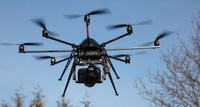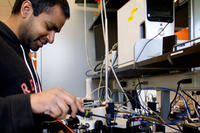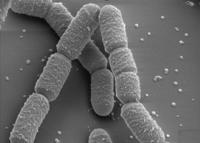-
Flying robots equipped with 3D gear: better surveillance on the cheap

Whether deployed to create virtual maps of difficult-to-access areas, monitor construction sites, measure contamination at nuclear power plants, assess conditions in a disaster-ravaged area, or identify rowdy soccer hooligans, mini UAVs could be used in a wide range of applications, obviating the need for expensive aerial photography or satellite imaging
-
-
Using nanomaterials to build safer, longer-lasting roadways
Asphalt is now made from petroleum, so it is very expensive; researchers tested two types of nanoclays, adding 2-4 percent by weight to asphalt; this is a smidgeon — less than half of a percent of the total weight of the asphalt pavement itself, but it made a big difference, and could make for safer, longer-lasting roadways
-
-
Novel radiation detection technology to thwart nuclear terrorism
Researchers at the Georgia Tech Research Institute (GTRI) are developing ways to enhance the radiation-detection devices used at ports, border crossings, airports, and elsewhere; the aim is to create technologies that will increase the effectiveness and reliability of detectors in the field, while also reducing cost
-
-
New DNA-based chemical sensor acts as an all-electronic nose
Chemical sensors are very good at detecting a single substance or a class of chemicals, even at highly rarified concentrations; biological noses, however, are vastly more versatile and capable of discriminating subtle cues that would confound their engineered counterparts; even highly trained noses, however, do leave a certain ambiguity when relaying a signal
-
-
Counterterrorism expert: democracy in Central Asia lost in translation
Democracy in post-Soviet Central Asia states failed not only because of the region’s Soviet legacy and hardships of transition, but also due to a lack of cultural competence among international, U.S., and EU agencies promoting democracy
-
-
Bomb-sniffing dogs used in Everglades python invasion

Burmese pythons have invaded the Florida Everglades, adapting well to the Everglades environment; they have also been wreaking havoc with the delicate ecosystem of the area; now, there is a new weapon in the fight against the Burmese python: dogs, trained to sniff out explosives, are being re-trained to locate the Burmese python
-
-
Smart gas sensors offer better chemical detection

Smart chemical sensors can detect chemical weapon vapors or indicators of disease better than the current generation of detectors; they also consume less power, crucial for stretching battery life on the battlefield, down a mineshaft, or in isolated clinics
-
-
Humble bacteria help create self-healing concrete

Scientists use a ground-borne bacteria — bacilli megaterium — to create calcite, a crystalline form of natural calcium carbonate; this can then be used to block the concrete’s pores, keeping out water and other damaging substances to prolong the life of the concrete
-
-
Android app for radioactivity detection

Just-release Android app uses software and the smartphone’s camera to measure radioactivity levels, allowing users to find out whether their environments are safe; the software is the civilian version of technology developed under contracts with the U.S. Department of Defense and with DHS
-
-
Rapid test strips detect swimming water contamination

Water-testing technology has never been fast enough to keep up with changing conditions, nor accessible enough to check all waters; researchers have developed a rapid testing method using a simple paper strip that can detect E. coli in water within minutes; the new tool can close the gap between outbreak and detection, improving public safety
-
-
Oklahoma University gets DHS research grant
The University of Oklahoma Health Sciences Center (OUHSC) was awarded a $490,000 grant from DHS for a 2-year study of how law enforcement officers utilize awareness of their surroundings to collect and then analyze intelligence related to potential terrorist threats
-
-
Australians told sweeping economic, societal changes needed to cope with severe weather
The Australian government’s Productivity Commission has just released its much-anticipated report, titled Barriers to Effective Climate Change Adaptation; the report calls for sweeping changes across the Australian economy, including ditching property taxes which discourage people from moving out of areas prone to extreme weather events
-
-
Feminine math, science role models do not motivate girls

Women who excel in male-dominated science, technology, engineering, and mathematic (STEM) fields are often unjustly stereotyped as unfeminine; if women are perceived as having feminine qualities, however, their success may actually decrease interest in STEM, particularly among young girls, according to a new study
-
-
New micro helicopters for search and rescue missions
New micro helicopters have a diameter of about fifty centimeters, weigh only 1,500 grams; they do not rquire GPS or remote control to navigate; they are designed to maneuver in tight or even enclosed spaces, and to detect and fly around any obstacle; possible uses could include protection or rescue missions, and they are ideal for flying over disaster areas and giving a picture of the situation from the air or locating victims
-
-
New academic homeland security journal launched
The inaugural issue of a new academic, peer-reviewed journal — the Journal of Homeland Security Education (JHSE)— is out; JHSE will focus on innovative concepts and models, strategies, technical tools, and theoretical and observational analyses; it also provides a platform for translational research that connects education to practice
-
More headlines
The long view
Autonomous Vehicle Technology Vulnerable to Road Object Spoofing and Vanishing Attacks
Researchers have demonstrated the potentially hazardous vulnerabilities associated with the technology called LiDAR, or Light Detection and Ranging, many autonomous vehicles use to navigate streets, roads and highways. The researchers have shown how to use lasers to fool LiDAR into “seeing” objects that are not present and missing those that are – deficiencies that can cause unwarranted and unsafe braking or collisions.
Tantalizing Method to Study Cyberdeterrence
Tantalus is unlike most war games because it is experimental instead of experiential — the immersive game differs by overlapping scientific rigor and quantitative assessment methods with the experimental sciences, and experimental war gaming provides insightful data for real-world cyberattacks.
Prototype Self-Service Screening System Unveiled
TSA and DHS S&T unveiled a prototype checkpoint technology, the self-service screening system, at Harry Reid International Airport (LAS) in Las Vegas, NV. The aim is to provide a near self-sufficient passenger screening process while enabling passengers to directly receive on-person alarm information and allow for the passenger self-resolution of those alarms.
Falling Space Debris: How High Is the Risk I'll Get Hit?
An International Space Station battery fell back to Earth and, luckily, splashed down harmlessly in the Atlantic. Should we have worried? Space debris reenters our atmosphere every week.
Testing Cutting-Edge Counter-Drone Technology
Drones have many positive applications, bad actors can use them for nefarious purposes. Two recent field demonstrations brought government, academia, and industry together to evaluate innovative counter-unmanned aircraft systems.
Strengthening the Grid’s ‘Backbone’ with Hydropower
Argonne-led studies investigate how hydropower could help add more clean energy to the grid, how it generates value as grids add more renewable energy, and how liner technology can improve hydropower efficiency.
